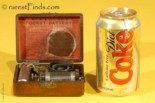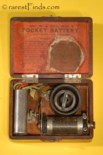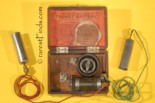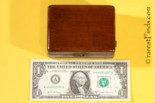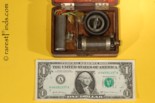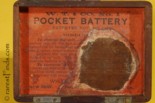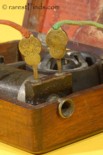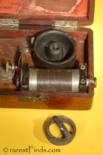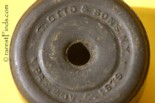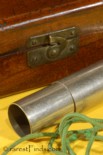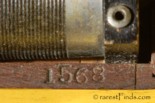Exceedingly rare Pocket Battery No.1. Sold!
Patents, click on any image to see larger image!





This Pocket Medical Electroshock Machine is by far the smallest I have ever seen. I did some research online and could not find another one like it. The open carbon zinc acid battery in a pocket version is a crazy idea.
Even if the jar containing the acid was emptied, the remaining vapors or fumes were still destroying the machine. The part of the paper label with instructions directly above the battery disintegrated. It is a miracle that the rest is still present AND complete.
The battery consist of a pressed or cast carbon jar with a diameter of 1-1/2 inches, and a height of only 3/4 of an inch. To connect the hand held electrodes patients would hold in their hands, tiny plugs are used. The cylindrical electrodes were so precisely machined that they slide inside each other. The inside of the inner cylindrical electrode functions as storage place for the two silk insulated stranded wires.
This has to be rare, very rare, a true “Pocket Battery ” or machine, only measuring 4 by 3 by 1-1/2 inches with an open jar containing acid! The “Pocket Battery No.1” must be the only one; there is no “Pocket Battery No.2.”
Unfortunately, part of the label with instructions is gone. It is a miracle that the rest is still present AND complete.
This Pocket Battery has the serial number of 1,568, see picture #11. It is hard to believe that so many were actually sold; often serial numbers were started at 1,000 to create the impression that at least 1,000 units were sold. However, the acid literally destroyed these little machines which would explain why this is most likely the only example still extant.
The idea to the Pocket size Battery is based on two patents; the patent with the title “IMPROVEMENT IN ELECTRO-MAGNETIC MACHINES” which protects the special battery with the number 221,291 issued to Luis Drescher on November 4, 1879, see patent above; and the Patent with the number 379,598, issued to Gustav Otto for the tiny “PLUG FOR MAKING ELECTRICAL CONNECTIONS” which was issued on March 3, 1888, see patent above. See also picture #7.
Drescher’s invention was to press carbon into the form of a round jar with a hole in the center as the negative element of the galvanic zinc-carbon battery. An insulated pin through the hole in the center supports the positive element, a zinc ring. The pin supporting the zinc ring functions as the conductor to the zinc ring, see picture #8 with the zinc ring removed. Picture #9 shows the bottom of the carbon jar with the embossed writing, “F. G. OTTO & SONS, N.Y. PAT. NOV. 4, 1879.”
Zinc-carbon galvanic elements are usually housed inside a glass jar for a good reason, the zinc and carbon electrodes slowly dissolve or are being used-up as the electrodes produces electricity; sooner or later, the carbon jar was used-up to the point where it leaked. Both electrodes, the carbon jar and the zinc ring look like new and do not show any signs of use.
The damaged paper label however is an indication that this little machine was used at least one time.
Condition:
Besides the red paper label inside the lid, this “Pocket Battery no.1” is in remarkable good condition. The wire with green insulation is frayed in two places, see picture #10. Other than that, I can not find any other defects.
History:
The-Medical_Battery_in_the_US_by_Anna_Wexler_2017.pdf
Portable shock-producing electrotherapeutic devices known as the medical battery in use between 1870-1920, provided both direct and alternating current and was thought to cure a wide variety of ailments. The product occupied a unique space at the nexus of medicine, consumerism and quackery; it was simultaneously considered a legitimate device by medical professionals who practiced electrotherapeutics. Yet identical versions were sold directly to consumers, often via newspaper advertisements and with cure-all marketing language [1].
The Medical Battery in The United States(1870-1920): Electrotherapy at Home and in the Clinic, by ANNA WEXLER, Journal of the History of Medicine and Allied Sciences, Vol. 72, No. 2, pp. 166–192 doi: 10.1093/jhmas/jrx001Advance Access Publication: March 16, 2017
What’s interesting about this Pocket Battery is that the device was made by the Whitall Tatum & Co. and the battery jar was made by the F. G. Otto & Sons Co. It Looks like the two companies worked together and supplied their product to each other; glass jars from Whitall Tatum & Co. to make batteries to F. G. Otto & Sons Co., and carbon jars to Whitall Tatum & Co.
Whitall Tatum & Co. was know for making glass insulators, druggist jars, bottles, milk shake machines, scales, and much more. The F. G. Otto & Sons Co. was known for making medical devices such as the Manhattan and Florence; civil war surgical sets, music boxes such as the Olympia, the very rare Capital Cuff with the conical metal cylinders, and the Criterion.
It is puzzeling that Whitall Tatum & Co. actually manufactured this Pocket Battery and not F. G. Otto & Sons Co., as F.G. Otto was manufactoring medical stuff and not Whitall Tatum. F.G. Otto without any doubt made the carbon jar and was the patentee of the tiny pluggs but the paper label names Whitall Tatum & Co. as the manufacturer. The answer to this question will be answered by reading [1].
Literature:
(Click on any title to see the online version of the book or publication if there is one.)
Inventory Number 09345;
Price: Sold!
